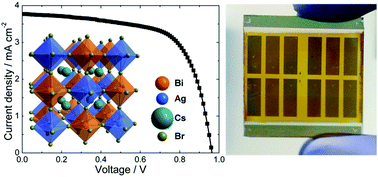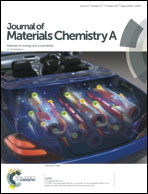Highly stable, phase pure Cs2AgBiBr6 double perovskite thin films for optoelectronic applications†
Abstract
Hybrid lead halide perovskites have emerged as high-performing semiconductors for optoelectronic applications such as photovoltaics. However, their toxicity and stability issues represent significant challenges. Recently, double perovskites have been suggested as an alternative and, especially, Cs2AgBiX6 (X = Cl, Br) has proved to be a promising material as it is non-toxic and highly stable. However, the low solubility of precursors has so far hampered the fabrication of high quality films. Here, we demonstrate for the first time the fabrication of Cs2AgBiBr6 films and incorporate them into working devices. Powder X-ray diffraction measurements revealed that high annealing temperatures of at least 250 °C are required to fully convert the precursors into Cs2AgBiBr6. After the optimization of the synthesis conditions, photovoltaic devices comprising our Cs2AgBiBr6 films show power conversion efficiencies (PCE) close to 2.5% and a open circuit voltage (Voc) exceeding one volt, which is currently the highest Voc reported for a bismuth halide based perovskite, showing the potential of double perovskites as the absorber material. Furthermore, our results revealed excellent stability of the devices upon exposure to working conditions without encapsulation. Our work opens the way to a new class of perovskites with significant potential for optoelectronic applications.

- This article is part of the themed collection: JMC A Editor’s choice collection: Recent advances in photovoltaics


 Please wait while we load your content...
Please wait while we load your content...